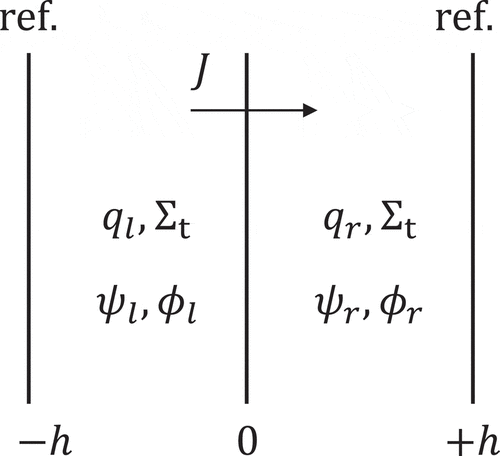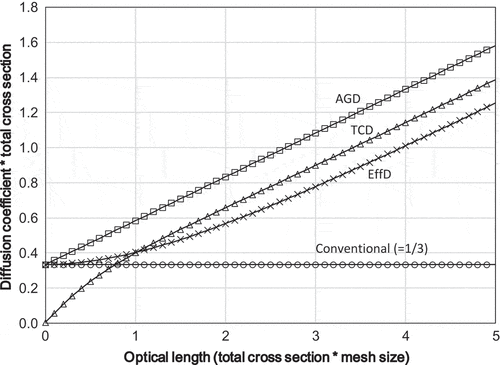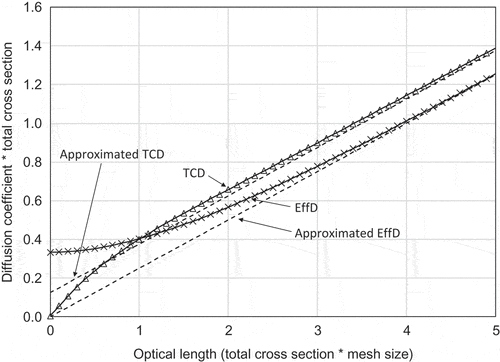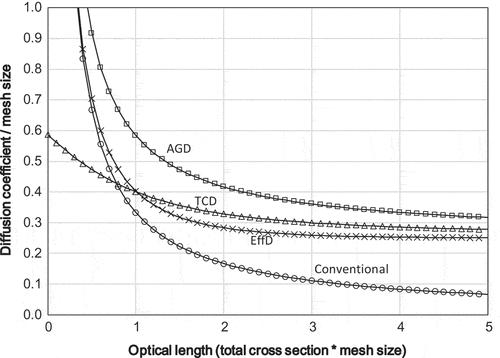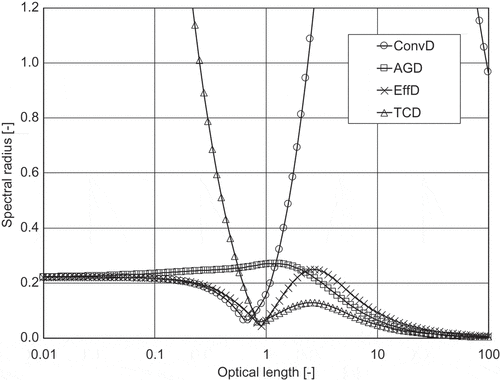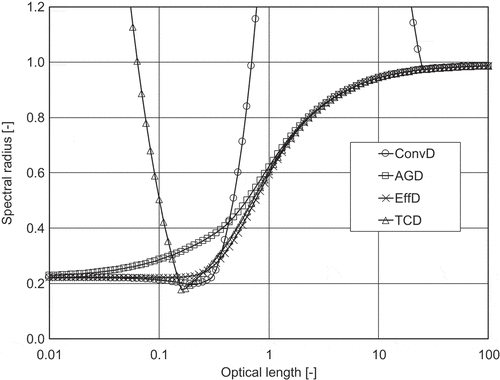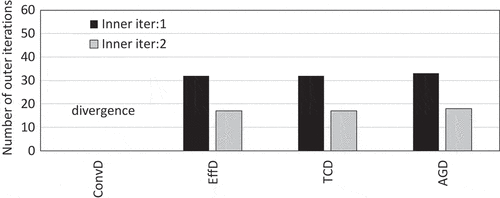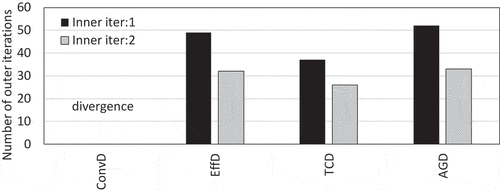 ?Mathematical formulae have been encoded as MathML and are displayed in this HTML version using MathJax in order to improve their display. Uncheck the box to turn MathJax off. This feature requires Javascript. Click on a formula to zoom.
?Mathematical formulae have been encoded as MathML and are displayed in this HTML version using MathJax in order to improve their display. Uncheck the box to turn MathJax off. This feature requires Javascript. Click on a formula to zoom.ABSTRACT
A diffusion coefficient for the coarse mesh finite difference (CMFD) acceleration is derived from the semi-analytic solution of one-group, one-dimensional, even-parity transport equation. The derived diffusion coefficient, i.e., the transport consistent diffusion coefficient (TCD), depends on the optical length of a mesh and shows similar behavior with the artificial grid diffusion (AGD) and the effective diffusion (EffD) coefficients for an optically thick mesh. Convergence properties of typical diffusion coefficients are evaluated using the linearized Fourier analysis. Analyses of the C5G7 3D benchmark problems with and without voided region are carried out to compare the convergence properties. The number of transport sweeps to reach convergence using TCD is smaller than that using EffD or AGD.
1. Introduction
The CMFD and the generalized coarse mesh rebalance (GCMR) acceleration methods are widely used for convergent acceleration of transport calculation based on the method of characteristics (MOC) [Citation1–Citation9]. The original idea of the CMFD method was developed by Smith for the acceleration of the advanced nodal method [Citation1]. Later, it has been applied to various neutronics analysis codes due to its efficiency with improvements and generalizations [Citation2–Citation9]. The CMFD and GCMR methods utilize the finite difference approximation based on the diffusion theory. Thus, the acceleration scheme depends on the diffusion coefficient used in the finite-difference approximation. It is well known that the CMFD and the GCMR methods show instability for a thick and diffusive mesh. In more detail, these non-linear acceleration methods generally show instability when the optical thickness of a mesh exceeds 1.0 when conventional diffusion coefficient is used [Citation4].
Various stabilization methods have been proposed and implemented, e.g., increasing the number of transport sweeps between CMFD accelerations, application of a damping factor, corrections on a diffusion coefficient [Citation10]. Among them, the present study focuses on the correction of diffusion coefficient.
Larsen et al. proposed the effective diffusion (EffD) coefficient to preserve the net current obtained by the step characteristics transport solution using the spatially discretized transport solution with the weighted diamond-difference scheme [Citation11]. Jarrett et al. introduced the artificial grid diffusion (AGD) coefficient to make the CMFD acceleration and the partial current based CMFD (pCMFD) acceleration [Citation12] equivalent [Citation10]. The EffD and the AGD coefficients make the CMFD and GCMR acceleration stable [Citation13]. The EffD and AGD coefficients are larger than the conventional diffusion coefficients. Stabilization of CMFD/GCMR acceleration with artificially increased diffusion coefficient is also pointed out by one of the authors [Citation4].
In this paper, the transport consistent diffusion (TCD) coefficient that preserves the semi-analytic solution of the one-group, one-dimensional, even-parity transport equation is derived. The two-node problem, which is commonly used in the CMFD acceleration method for the advance nodal method, is used for derivation. The even-parity transport equation is used for derivation due to its similarity with the diffusion equation.
In Section 2, derivation of the transport consistent diffusion coefficient and convergence analysis methodology of the CMFD acceleration using the linearized Fourier analysis are described. Numerical results are shown in Section 3. Finally, concluding remarks are described in Section 4.
2. Theory
2.1. Derivation of transport consistent diffusion coefficient
The derivation of TCD coefficient is explained in this section. Firstly, the even-parity transport equation is derived followed by the explanation on the analytic solutions of even-parity and odd-parity angular fluxes. Secondly, the spatially averaged even-parity angular flux inside a mesh is obtained using the analytic solution of even-parity angular flux. Then, the spatially averaged scalar flux inside a mesh is obtained by solid angle integration of the average even-parity angular flux. Thirdly, the neutron net current at mesh interface is derived by the solid angle integration of the odd-parity angular flux at the interface. Finally, the TCD coefficient is derived using Fick’s law.
The transport equation for one-group, one-dimensional, homogeneous geometry with an isotropic source is written as:
where
: direction cosine,
: position,
: macroscopic total cross section,
: angular flux for direction
and position
,
: fixed source.
The transport equation for the opposite direction is given by:
By adding and subtracting EquationEquations (1)(1)
(1) and (Equation2
(2)
(2) ), the following equations are obtained:
where are the even- and odd-parity angular fluxes defined as:
By eliminating using EquationEquations (3)
(3)
(3) and (Equation4
(4)
(4) ), the even-parity transport equation is obtained:
Now let us consider a two-node problem shown in , which is usually used to derive the coupling coefficient of CMFD acceleration in the advanced nodal method [Citation1]. Here, and
are spatially uniform isotropic neutron sources,
and
are angular fluxes,
and
are scalar fluxes, respectively. Sizes for the left and the right meshes are h, and the origin is set at the mesh boundary between the left and right meshes. Spatially uniform total cross section
is considered. Reflective boundary condition is applied both for the left and right boundaries.
EquationEquation (7)(7)
(7) can be analytically solved using the following boundary conditions:
where is the mesh width as shown in . The first two are the reflective boundary condition. The third and fourth ones correspond to the continuity condition at material interface.
The analytic solutions of even-parity angular fluxes are given by:
where and
are fixed sources as shown in .
Using EquationEquations (9)(9)
(9) and (Equation10
(10)
(10) ), the odd parity angular flux at the mesh interface
, the spatially averaged even parity angular fluxes
and
are given by:
Using EquationEquations (11)(11)
(11) , (Equation12
(12)
(12) ), and (Equation13
(13)
(13) ), the net neutron current
at the mesh interface, the average scalar fluxes for the left and the right meshes
are given by:
Forcing the Fick’s law, the following relation is obtained:
where is the transport consistent diffusion (TCD) coefficient.
By substituting EquationEquations (14)(14)
(14) , (Equation15
(15)
(15) ), and (Equation16
(16)
(16) ) into EquationEquation (17)
(17)
(17) ,
can be expressed as:
where is the optical length of a mesh. It should be noted that
depends on
and
, and but it does not depend on
and
.
2.2. Convergence analysis
Convergence analysis of the CMFD acceleration is carried out using the linearized Fourier analysis. The analysis procedure has been published in many previous works [Citation14–Citation16] but somewhat complicated. Therefore, the detailed description of the linearized Fourier analysis is provided as the supplemental material of this paper. In the following, the fundamental equations used for the linearized Fourier analysis are described in order to clarify the condition of convergence analysis.
The neutron transport equation in one-dimensional slab geometry assuming the step characteristics is written as:
where
: direction cosine for direction n,
: angular flux,
: scalar flux,
: mesh width,
: macroscopic total cross section,
: macroscopic scattering cross section,
: neutron source,
: weighting factor to calculate average angular flux,
: quadrature weight,
: index of iteration,
: index of mesh,
indicates mesh interface between
and
,
: index of direction.
In the CMFD acceleration, the following difference equation is used to represent the neutron net current.
where
and
: diffusion coefficient,
: index of coarse mesh,
indicates mesh interface between
and
,
: number of fine meshes in a coarse mesh.
Using EquationEquation (22)(22)
(22) , the CMFD equation is written as:
where .
Once the CMFD solution is obtained, the scalar flux is normalized as:
EquationEquations (19)(19)
(19) , (Equation25
(25)
(25) )–(Equation28
(28)
(28) ) consist a set for CMFD acceleration. These equations are used for the convergence analysis using the linearized Fourier analysis.
3. Numerical results and discussions
3.1. Comparison of diffusion coefficients
The transport consistent diffusion (TCD) coefficient derived in Section 2.1 is compared with the conventional diffusion coefficient (ConvD), the effective diffusion coefficient (EffD), and the artificial grid diffusion coefficient (AGD). The definitions of ConvD, EffD, and AGD are as follows:
Comparison of the diffusion coefficients is shown in . Note that dimensionless parameter, , is shown. Behavior of
is similar to those of
and
while that of
is different.
When the optical thickness of a mesh is large,
and
can be approximated by:
The approximated and
are shown in .
By comparing EquationEquations (31)(31)
(31) , (Equation32
(32)
(32) ), and (Equation33
(33)
(33) ), the dependence of these diffusion coefficients on the optical mesh size
is characterized by
. Ref. [Citation13] revealed that the stabilization effect of
and
is similar. This suggests that utilization of
will also contribute to improve stability of the CMFD/GCMR acceleration methods.
indicates the relation between optical length and . It is interesting that
converges to a finite value (~0.586) when
approaches 0. It means that
gives a finite diffusion coefficient for a void region with a finite mesh size, which would have a positive impact on convergence of the CMFD/GCMR acceleration.
3.2. Convergence estimation using the linearized fourier analysis
Three major parameters affecting the convergence of the CMFD acceleration are considered in the linearized Fourier analysis as follows:
Scattering ratio (
): 0.99
Number of fine meshes in a coarse mesh: 1, 4
Optical thickness of a coarse mesh: 10−2–102
The results of linearized Fourier analysis for four different diffusion coefficients are shown in and . The results indicate that ,
, and
show similar convergent behavior for optically thick meshes, which increases convergence stability. Contrary, the spectral radius of
becomes large for an optically thin mesh. The numerical result shows that
approaches approximately 0.6 for an optically thin mesh. The previous study [Citation4] revealed that the CMFD acceleration method is consistent with the coarse mesh rebalance (CMR) when
. Therefore, the performance of
would be similar to that of CMR for optically thin meshes. Performance of these diffusion coefficient in actual heterogeneous geometry will be confirmed in Section 3.2.
3.3. Convergence estimation in C5G7 3D benchmark problem
The TCD is derived assuming a very simplified condition (one-group, one-dimensional slab geometry with a uniform fixed source in each region), and the linearized Fourier analysis also assumes a simplified condition. Therefore, its performance evaluation in more realistic conditions is desirable. In this section, the impact of diffusion coefficient on the convergence of the CMFD acceleration is verified through the C5G7 3D benchmark problem [Citation17]. In the original C5G7 benchmark problem, the non-voided condition is specified, but the voided condition is also considered in this study. The GENESIS code, which is a three-dimensional transport code based on the Legendre polynomial Expansion of Angular Flux (LEAF) method, is used [Citation18]. The calculation conditions are as summarized as follows:
Number of azimuthal angles: 8 for 2π
Number of polar angles (Gauss-Legendre): 4 for π
Ray trace width: 0.2 cm
Axial mesh size: 3.0 cm
Radial mesh division
Number of inner iterations: 1 or 2
Convergence criterion for k-effective:
Convergence criterion scalar flux:
Mesh size for CMFD: 1 cell and 3.0 cm for radial and axial directions, respectively
The above discretization parameters are too coarse to obtain the converged results [Citation18], but they are appropriate in the present study since the evaluation of convergence behavior of the CMFD acceleration is the major purpose in this paper, and the convergence behavior of the CMFD acceleration is not very sensitive to the discretization parameters. It should be also noted the damping factor [Citation10,Citation13] is not used to stabilize the CMFD acceleration. The specification of the voided condition is taken from Ref. [Citation18].
Calculation results are shown in and . Note that each CMFD calculation has been fully converged in each acceleration. Performances of ,
, and
are similar in the non-voided case, while
shows better performance in the voided case. This result seems to be somewhat inconsistent with that of the linearized Fourier analysis since convergence performance of
is worse than
and
for an optically thin mesh. A possible reason for the better convergence of
would be the value of diffusion coefficients. The value of
,
, and
could become large for voided region, which has a negative impact on the convergence of a diffusion calculation, while that of
is finite. This might be a cause of the difference of convergence behavior observed in the voided case. However, further study on the convergence property of CMFD acceleration in realistic heterogeneous geometry will be desirable to clarify and to understand this issue. For example, linearized Fourier analysis considering different total cross sections and the periodic boundary condition would be an approach to address this question. Such a study, unfortunately, requires considerable new development works thus is considered as a future task.
4. Conclusion
The transport consistent diffusion (TCD) coefficient is derived using the even-parity transport equation and the two-node problem in one-dimensional geometry. TCD depends on the optical mesh size and shows similar behavior with the effective diffusion (EffD) and the artificial grid diffusion (AGD) coefficients for an optically thick mesh.
Convergence performances of TCD, AGD, EffD, and conventional diffusion coefficient (ConvD) are compared through the linearized Fourier analysis and numerical calculations in the C5G7 3D benchmark problem. The linearized Fourier analysis indicates that TCD, AGD, and EffD show similar theoretical convergence behavior for an optically thick mesh. In the C5G7 3D benchmark problem, TCD, AGD, and EffD show better performance than ConvD in the non-voided and voided conditions. In the voided condition, TCD is superior to AGD and EffD. This reason would be the limited value of TCD, which does not become very large for a voided region. However, further investigation on better performance of TCD in highly voided condition would be desirable, e.g., linearized Fourier analysis considering different total cross sections and the periodic boundary condition.
The above results suggest that the TCD will be a candidate for the CMFD acceleration which can be robustly used not only for conventional calculation conditions but also for highly voided conditions.
Supplemental Material
Download MS Word (68.4 KB)Acknowledgments
This work was supported by the JSPS KAKENHI, Grant-in-Aid for Scientific Research (C) [16K06956].
Disclosure statement
No potential conflict of interest was reported by the authors.
Supplementary material
Supplemental data for this article can be accessed here.
Additional information
Funding
References
- Smith K. Nodal method storage reduction by non-linear iteration. Trans Am Nucl Soc. 1983;44:265–266.
- Smith K, Rhodes JD Full-core, 2-D, LWR core calculations with CASMO-4E. Proc. PHYSOR2002; 2002 Oct 7–10; Seoul (South Korea). [CD-ROM].
- Joo HG, Cho JY, Kim KS, et al. Methods and performance of a three-dimensional whole-core transport code DeCART. Proc. PHYSOR2004; 2004 Apr 25–29; Chicago Illinois (US). [CD-ROM].
- Yamamoto A. Generalized coarse mesh rebalance method for acceleration of neutron transport calculations. Nucl Sci Eng. 2005;151:274–282.
- Yamamoto A, Endo T, Tabuchi M, et al. An advanced lattice physics code for light water reactor analyses. Nucl Eng Technol. 2010;42:500–519.
- Jung YS, Shim CB, Lim CH, et al. Practical numerical reactor employing direct whole core neutron transport and subchannel thermal/hydraulic solvers. Ann Nucl Energy. 2013;62:357–374.
- Boyd W, Shaner W, Li L, et al. The openMOC method of characteristics neutral particle transport code. Ann Nucl Energy. 2014;68:43–52.
- Zhu A, Transient methods for pin-resolved whole core transport using the 2D-1D methodology in MPACT. Proc. M&C2015; 2015 Apr 19–23; Nashville Tennessee (US). [USB-DRIVE].
- Chen J, Liu Z, Zhao C, et al. A new high-fidelity neutronics code NECP-X. Ann Nucl Energy. 2018;116:417–428.
- Jarrett M, Kochunas B, Zhu A, et al. Analysis of stabilization techniques for CMFD acceleration of neutron transport problems. Nucl Sci Eng. 2016;184:208–227.
- Larsen E Infinite medium solutions to the transport equation, Sn discretization schemes, and the diffusion approximation. Proc. of the Joint International Topical Meeting on Mathematics and Computation and Supercomputing in Nuclear Applications; 2001 Sep 9–13; Salt Lake City, UT, (USA). [CD-ROM].
- Cho NZ, Lee GS, Park CJ. Partial current-based CMFD acceleration of the 2D/1D fusion method for 3D whole-core transport calculations. Trans Am Nucl Soc. 2003;88:594–596.
- Yamamoto A, Giho A, Endo T. Recent developments in the GENESIS code based on the Legendre polynomial expansion of angular flux method. Nucl Eng Technol. 2017;49:1143–1156.
- Cefus GR, Larsen EW. Stability analysis of the coarse-mesh rebalance. Nucl Sci Eng. 1990;105:31–39.
- Hong SG, Kim KS, Song JS. Fourier convergence analysis of the rebalance methods for discrete ordinates transport equations in eigenvalue problems. Nucl Sci Eng. 2010;164:33–52.
- Kim HT, Kim Y. Convergence studies on nonlinear coarse-mesh finite difference accelerations for neutron transport analysis. Nucl Sci Eng. 2018;191:136–149.
- Benchmark on Deterministic Transport calculations without spatial homogenisation—MOX fuel assembly 3-d extension case. NEA/NSC/DOC(2005)16. 2005. Organisation for Economic Co-operation and Development/Nuclear Energy Agency.
- Yamamoto A, Giho A, Kato Y, et al. - a three-dimensional heterogeneous transport solver based on the Legendre polynomial expansion of angular flux method. Nucl Sci Eng. 2017;186:1–22.

